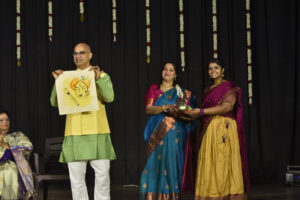Ever sat in the audience during a Rangapravesam and found yourself completely swept away—not just by the dancer, but by the music?
That’s no accident. The right soundtrack can make or break a performance. Whether it’s the power of a rhythmic jathi or the emotional pull of a padam, Rangapravesam songs shape the entire atmosphere of the event.
In this blog, we’ll walk you through how music choices—classical, emotional, and high-energy—play a crucial role in making any Rangapravesam unforgettable.
And if you’ve ever been confused between Rangapravesam vs Arangetram, we’ll clear that up too.
Understanding the Importance of Rangapravesam Songs
For a debut solo recital, music isn’t just background—it’s the backbone. The dancer’s every step, glance, and expression are choreographed to complex rhythmic cycles and melodic frameworks.
In a Kuchipudi Rangapravesam, for instance, a dancer may include:
- Traditional Telugu compositions
- Sanskrit verses for invocatory items
- Carnatic classics with emotional depth
- Rhythmic jathis performed in sync with live percussion
The music must:
- Match the dancer’s strengths
- Stay true to the style (like Kuchipudi or Bharatanatyam)
- Guide the flow of the performance
- Evoke emotion, grace, and energy at just the right moments
Rangapravesam Meaning and How Music Connects to It
Let’s pause for a second—what’s the Rangapravesam meaning?
In simple words, it means “entry to the stage.” It’s your solo debut, typically in Kuchipudi, much like an Arangetram in Bharatanatyam.
But it’s not just a public performance.
It’s a deeply spiritual, emotional, and personal moment. You’re no longer dancing in class—you’re telling stories to a live audience.
And every story needs the right soundtrack.
Read more about preparing for your Rangapravesham here:
The Thrill of Rangapravesham – A Performer’s Perspective
Essential Rangapravesam Songs for Every Segment of the Performance
Each section of a Rangapravesam needs a very specific sound and emotion. Here’s a breakdown:
Pushpanjali or Prayer Song
Start with a soft, respectful invocation. Good options include:
- “Pushpanjali” in Arabhi Ragam
- “Ganesha Pancharatnam” by Adi Shankara
- Any stuti dedicated to Lord Nataraja
Jathiswaram or Pure Dance
This segment needs rhythm-driven, percussion-rich tracks.
- Arabhi or Vasantha Ragam Jathiswarams are popular
- Telugu compositions with mridangam-heavy beats are preferred
Shabdam – For Light Narratives
Shabdams usually feature devotional or romantic themes:
- “Sarasijanabha” in Kambhoji Ragam
- “Ra Ra Maa Intiki” (Krishna-based)
These require expressive vocals and moderate tempo to allow for storytelling.
Varnam – The Soul of the Performance
This is the emotional and technical centrepiece of the event.
You’ll need:
- A powerful Ragam (like Bhairavi, Kalyani, or Saveri)
- Lyrics that reflect longing, bhakti, or strength
- A vocalist who can match the dancer’s expressive range
Examples:
- “Mohamana” (Bhairavi Ragam)
- “Swami Naan Undan Adimai” (Nattakurinji Ragam)
Padams and Javalis – For Pure Abhinaya
Choose slow-paced, meaning-rich songs:
- “Yaro Ivar Yaro” (Bhairavi)
- “Idhu Daan Varundha Kaalam”
- “Sakhi Prana”
These compositions allow deep emotional connection between dancer and audience.
Tillana – High-Energy Finish
This is where the dancer shows off energy and finesse.
Top Tillana picks:
- “Tillana in Dhanashree Ragam”
- “Tillana in Brindavani”
- “Annamacharya Tillana” (Telugu)
The rhythm, speed, and intricate footwork in these pieces close the performance with a bang.
Rangapravesam vs Arangetram – What’s the Difference?
It’s easy to mix these up, especially if you’re not familiar with classical dance traditions.
Here’s the simple difference:
| Term | Dance Style | Region | Language |
| Arangetram | Bharatanatyam | Tamil Nadu | Tamil |
| Rangapravesam | Kuchipudi | Andhra Pradesh / Telangana | Telugu |
But emotionally and structurally, they serve the same purpose. Both are solo debut performances granted after years of dedicated training, usually under a Guru.
If you’re unsure about which one you’re planning, always clarify the dance style first. Both require similar levels of preparation and musical excellence.
Related Resources on Rangapravesam
- Rangapravesam Insight: What Is a Rangapravesam?
- Sri Sai Dance Academy’s Rangapravesam Overview
- Explore More with Ragam & Thalam
Stats to Note
- 78% of dance teachers say the Varnam is the most challenging piece to musically align
- 60% of students pick a Krishna-themed Padam for their debut
- 90% of parents say the music choice deeply impacts audience engagement
In short: music matters more than you think.
FAQs About Rangapravesam Songs and Music
Do I need a live orchestra for my Rangapravesam?
Live musicians are ideal for authenticity and dynamic expression, but pre-recorded tracks are acceptable with Guru’s guidance.
Can I include a film song in my Rangapravesam?
No. Rangapravesam follows classical formats and must use Carnatic-based, traditional compositions approved by your teacher.
How many total songs are usually performed?
Anywhere between 8 to 10, covering all traditional segments from Pushpanjali to Mangalam.
Can I choose songs in Hindi or Sanskrit instead of Telugu?
Yes, but only if it aligns with your performance style and Guru’s approval. Telugu is most common in Kuchipudi.
How long should each musical piece be?
Shorter pieces like Alarippu run 3–5 minutes. Varnam may go up to 25 minutes. Total performance: 90 to 120 minutes.
Let Your Dance Tell a Story Through Song
Your Rangapravesam isn’t just about choreography—it’s a musical journey from invocation to celebration. Every Rangapravesam song you choose should say something about your voice, your story, and your strength.
So choose music that lifts your performance. Pick lyrics that speak to your heart. And let the rhythm lead you where words cannot.
Need help curating your recital music set?
Talk to our team at Ragam & Thalam for performance prep, song selection, and practice resources.





